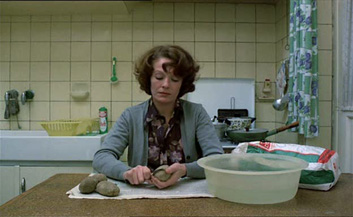|
|
Sole Criterion: Jeanne Dielman, 23 quai du Commerce, 1080 BruxellesBy Brett Ballard-BeachFebruary 2, 2012
By far the boldest decisions by Akerman and Mangolte are to have no close-ups, no reverse angle shots, and no point-of-view shots. Any one of those, even deployed sparingly, would help the audience into Jeanne’s world (and Seyrig’s process) even if just for a moment by filling the frame with her countenance or serving as a proxy so we can truly “see” what she is looking at, and by extension, gain insight into what she is thinking. Consider it anti-3D: Akerman refuses to meet the audience even halfway with the image, let alone send it shooting out over us, thereby forcing us to move ourselves closer to the image, perhaps physically, but psychically as well. Another ironic contradiction: hiring an internationally acclaimed actress such as Seyrig, setting her in the heart of domestic drudgery (but with meticulously coiffed hair) and keeping her at a distance from the viewer for the length of the film. Seyrig does an incredible job of internalizing Jeanne’s feelings as needed, and letting us share in the maddening scenes of time creeping along that occurs in the film’s final third when Jeanne’s routine is upset yet again by rising too early, thereby throwing off her timing entirely for her regimented day. The tension that accumulates throughout the day culminates in a finale that offers different levels of release (an orgasm, an act of violence, sitting alone in a darkened living room) but the film resolutely refuses to end by explaining anything, as Akerman remains true to her heroine’s enigma-wrapped-in-a-riddle qualities. And if there is one defining image, for me, of Seyrig as Jeanne, it is in the look on her face as Thursday’s gentleman client lies on top of her (for once, the camera enters the bedroom) and they silently have intercourse. She has an orgasm and her face and posture encapsulate the gamut of emotions: ecstasy, terror, loathing, and panic. It is possible this may be her first ever orgasm. We can see this play of emotions, but what does she really think about it? About her life? Her family? We are presented with a film’s worth of clue and left to the devices of our own interpretations. Akerman dodged and circumvented numerous pitfalls with Jeanne Dielman, not the least of which was resisting the temptation to settle for bullying and telling the audience how to feel. Her film is feminist in spirit and production but isn’t simply a tract on the woes of a single mother. It’s experimental in the extreme, but with a star performance at its center capturing a character who, at her core, wouldn’t be out of place in a sudsy Douglas Sirk melodrama from the ‘50s. Every detail feels precise and planned (but not fussed over) yet the film’s emotional plot unravels so spectacularly it feels as if improvisation could take over and anything could happen. And at the end, I come back to the title. Her name is Jeanne Dielman, she lives in Belgium, at this particular address. Of that, at least, I can be confident. Next time: A Beach Boy. Sweet Baby James. Miles and miles of open road. The defining film of the 1970s car culture genre. DVD Spine # 414.
|

|
|
|

|
Friday, November 1, 2024
© 2024 Box Office Prophets, a division of One Of Us, Inc.


